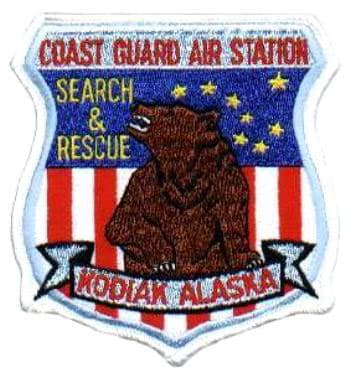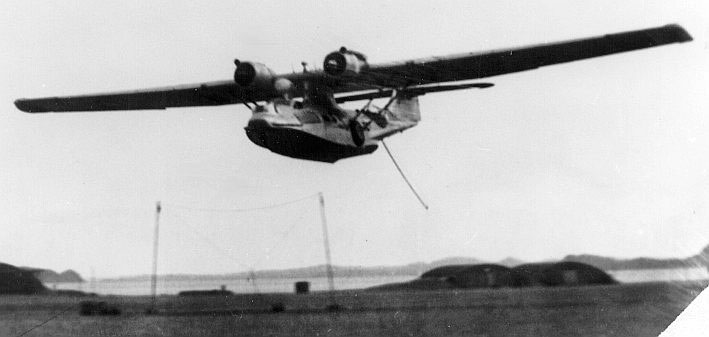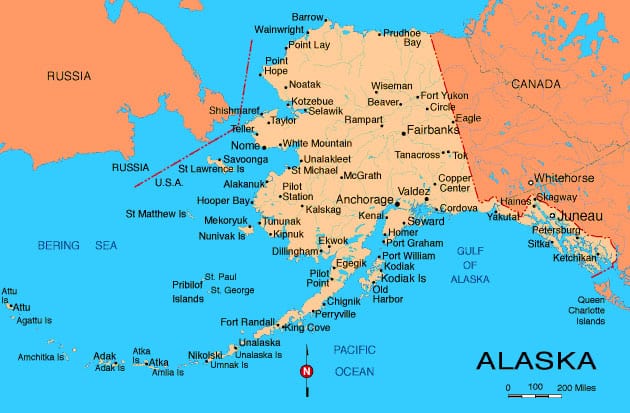 The USCGC Spencer, a newly commissioned 327 foot Treasury Class cutter, was enroute to Cordova, Alaska where it would be based. The 327 foot cutters were capable of carrying an aircraft. Captain Lloyd Chalker, the Chief of Coast Guard Aviation, directed Lt. C.F Edge to put a JF-2 amphibian aboard the Spencer and assigned him as the pilot. His mission was to reconnoiter Alaska for a suitable site for a Coast Guard air base. During 1937 Edge examined seven locations along the Alaska Coast from Ketchikan to the Aleutians. He recommended Kodiak. He stated none of the locations was ideal but Kodiak was acceptable and centrally located to Coast Guard operations. The Navy concurred with Edge’s opinion except they chose Woody Island as the location for a seaplane base. Edge felt that Woman’s Bay was a better location. Chalker arranged a meeting with the Navy and after Edge’s briefing they agreed that Woman’s Bay should be the location. The Navy began surveys and construction in 1938 and on June 15, 1941 NAS Kodiak was established.
The USCGC Spencer, a newly commissioned 327 foot Treasury Class cutter, was enroute to Cordova, Alaska where it would be based. The 327 foot cutters were capable of carrying an aircraft. Captain Lloyd Chalker, the Chief of Coast Guard Aviation, directed Lt. C.F Edge to put a JF-2 amphibian aboard the Spencer and assigned him as the pilot. His mission was to reconnoiter Alaska for a suitable site for a Coast Guard air base. During 1937 Edge examined seven locations along the Alaska Coast from Ketchikan to the Aleutians. He recommended Kodiak. He stated none of the locations was ideal but Kodiak was acceptable and centrally located to Coast Guard operations. The Navy concurred with Edge’s opinion except they chose Woody Island as the location for a seaplane base. Edge felt that Woman’s Bay was a better location. Chalker arranged a meeting with the Navy and after Edge’s briefing they agreed that Woman’s Bay should be the location. The Navy began surveys and construction in 1938 and on June 15, 1941 NAS Kodiak was established.
During World War II a Coast Guard PBY and a PBY-5A operated out of Kodiak performing aerial mapping and support for the LORAN A chains being established in Alaska. A permanent Air Detachment, consisting of a PBY-5A, seven pilots and 30 crewmen, was commissioned on April 17, 1947. Several weeks later a second PBY-5 arrived. Initial duties were Search and Rescue and air support for outlying

units. In the early days, logistic support required aerial delivery of cargo by parachute and pick ups were made with a pick-up hook protruding from the tail hatch. The package to be picked up was hung on a line stretched between two poles. Cape Sarichef LORAN station was supported by operating out of the Old Sennat Point landing strip. The runway was smoothed out lava rock with series of oil drums marking the edges of the landing strip. Summer of 1952 saw the addition of a third PBY-5A and search and rescue continued to be the primary activity as medical evacuations from remote areas continued to increase. During the summer of 1953 one PBY-5A and crew were deployed to Point Barrow for the purpose of ice observation during the DEWLINE support operation. By the end of the year the first UF-1G Grumman Albatross had arrived. Icing was a problem and in 1957 the UF-1Gs were replaced by the extended wing UF-2Gs which gave much better performance.
In May of 1957 the Commanding Officer of the Coast Guard Air Detachment accepted the duties of Kodiak SAR Coordinator from the Commanding Officer of US Naval Station Kodiak. This meant an increased role for the air detachment as the operational control of all USCG Cutters deployed within the area and several US Navy aircraft and surface vessels to carry out the SAR mission became their responsibility. In 1960 with the construction of LORAN C stations a C-123 transport was assigned to the station. Two Bell HUL-1G helicopters were assigned, primarily for use on icebreakers during the Bering Sea Patrols but they were additionally used for SAR. The helicopters could be carried in the C-123 greatly increasing their utilization potential. Law enforcement patrols increased in 1963 and the aircraft compliment was increased to four UF-2Gs.

On 1 July 1964 the unit was designated an air station. It had grown from one PBY-5A, seven officers and 30 crewmembers to 26 officers and 100 enlisted personnel. January of 1966 saw the arrival of the HH-52 helicopter. The first HC-130 was assigned in 1968 and in 1972 the first HH-3F helicopter arrived. The Navy’s role in Kodiak also terminated in 1972 and the entire complex was transferred to the Coast Guard. By 2002 the air station had a diverse inventory of five HH-65 helicopters, four HH-60J helicopters and five HC-130H tactical fixed wing aircraft. The HH-65 operates as a short range SAR and Law Enforcement asset regularly deployed on Alaska Patrol cutters. The HH60J is a long range SAR asset and the SAR workhorse of the unit. HC-130s provide long range SAR and helicopter escort and a most capable law enforcement platform patrolling the vast area of responsibility. SAR detachments are maintained at Cordova from May through September and St. Paul Island during the crab seasons. The Air Station is the major tenant of Integrated Support Command (ISC) Kodiak, and the largest command in the Pacific Area (PACAREA).
The mission of the Coast Guard Air Station Kodiak is to provide aircraft and crews in support of the Coast Guard’s core missions which include Search and Rescue Operations, covering 4 million square miles including the Gulf of Alaska, Bristol Bay, Bering Sea and the Pacific Ocean above latitude 40N. Enforcement of Laws and Treaties primarily focused on the nation’s most active fisheries; logistical support of isolated Coast Guard units; Marine environment protection; Aids to navigation; Military defense; and assistance to numerous local, state and federal agencies.

